My suggestion to use some glamorous Oakshott Silks in a Twin Needling Stained Glass project was chosen and I was very kindly asked to write a tutorial.
And here it is!
Twin needling is sewing with 2 needles in your machine, and 2 spools of thread, at the same time!
When you get the hang of this technique, it is so much fun, and the possibilities are endless.
The most common way to use twin needling to great effect is in Stained Glass Windows patchwork:
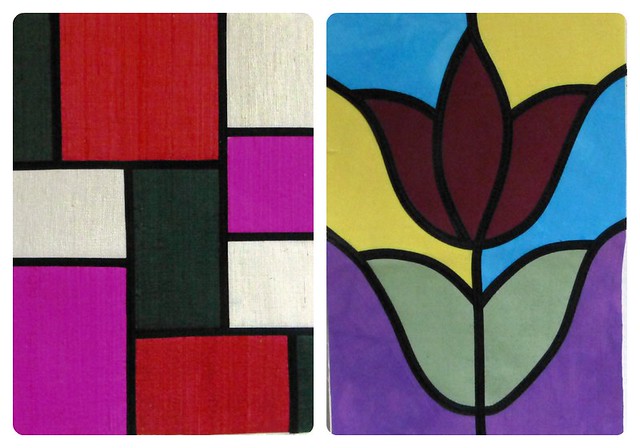
The bit that you are twin needling is the 'leading' otherwise known as Fusible Bias Tape.
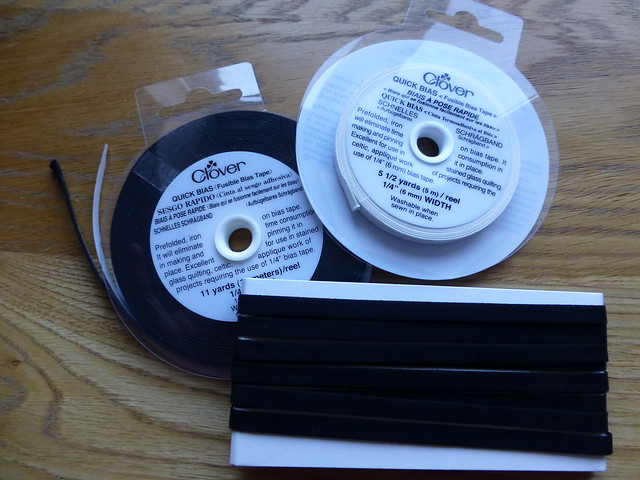
This is such a cool product and worth every penny. It comes in different colours & widths, but I use the 1/4" tape with a 1/4" twin needle (twin needles also come in different widths). And because it has been made on the bias, it curves really nicely!
So here's how you twin needle!
Ever wondered what the extra spool holder & hole was for in your machine? As well as the hooks on the sides of your needle shank? Yep, you guessed it! Twin Needling.
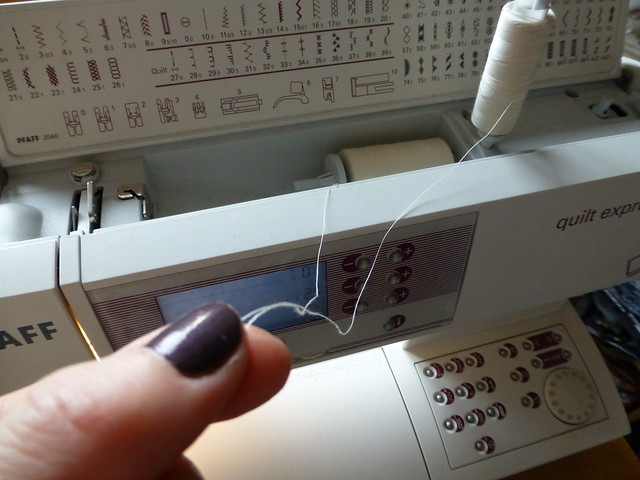
Put 2 spools of thread into the top of your machine. Some of you may have spool holders that are permanently fixed on the top of your machine, some of you may have one that is fixed and a hole to slot in your spare spool holder.
Now take both threads together, and thread your machine as normal, until you get to the needle shank.
This is where you separate the threads again. Hook one thread to one side, and the other thread to the other side.

Insert your twin needle unit in the same way you put in a normal needle and thread each needle.
You should now have 1 bobbin thread and 2 top threads. Increase your stitch length to 3.
Iron a small piece of fusible bias tape onto a scrap of fabric (always double your fabric) & practise your twin needling until you get the tension right (you may need to loosen your tension as the fusible tape is quite thick).
This is what it should look like on the back:
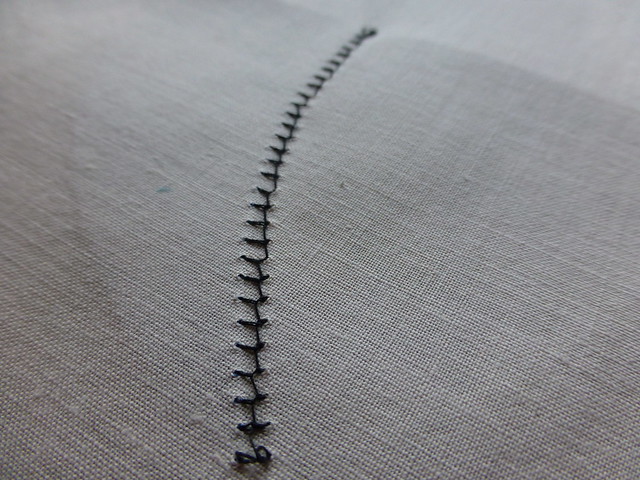
Now you are ready to twin needle your project.
There are 2 ways to do Stained Glass Windows:
1. Using bondaweb to stick down your design and then twin needle the 'leading' on top (check the compatibility of the bondaweb with the fabric you are using).

This method is good for more intricate, curved designs.
2. Make an improve patchwork block and twin needle the 'leading' onto the right side of the seams.
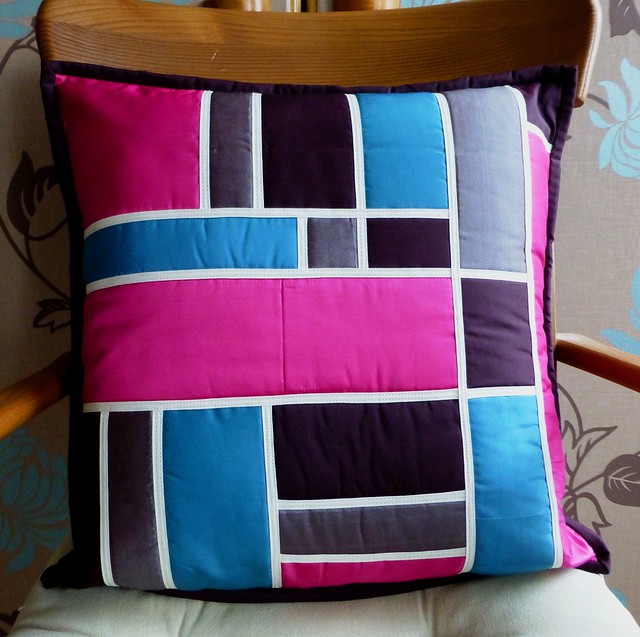
What you must remember when making stained glass patterns, is the raw edges of a length of bias tape must be hidden underneath another length of bias tape (rather like foundation piecing where the last raw edge gets sewn over by the next piece of fabric).
Method 2 is a good way to start twin needling if you are a first timer!
Here are the picture steps for Method 2 followed by the tutorial:
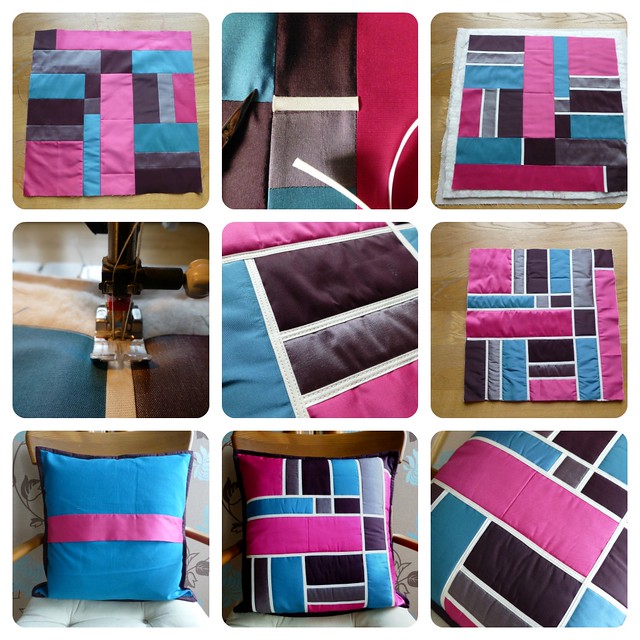
1. Make an improve block to your required size. I made a 16" square panel for a cushion front.
2. Study the seams of your block to find out which ones will need bias tape first, and which ones have ends that will need to be covered over by another piece of bias tape. Peel the back off the tape and start ironing on the sections that need to be sewn down first. Make sure the tape ends reach right into the seams.
3. Baste the block onto some wadding, backed with calico/sheeting.
4. Take your block to the machine and start twin needling the smaller pieces of bias tape that are stuck down. You don't need to start or finish with a reverse stitch, just make sure you sew right to the ends of the tape.
5. Continue building up the layers of bias tape until all raw edges & seams are covered.
6. Trim off any excess wadding/backing.
7. Attach a cushion back and binding if desired.
8 & 9. Sit back and admire your handiwork!
Thank you for taking the time to read this tutorial.
I hope you have been inspired to try something new and have loads of Twin Needling fun!



This is so great! It looks brilliant and it sounds so fast and easy. I would love to take a try (if I could find out where to get all the stuff) but unfortunately I lost my second spool holder.
ReplyDeleteBrilliant Judith! Really, I could almost be tempted to,finally use that double trouble brighter! Your cushion is gorgeous!
ReplyDeleteThis is marvellous Jude. What an interesting project and I am so glad someone finally explained to me what twin needling is. Very tempted indeed to give this a go soon.
ReplyDeleteOh my! That is brilliant. Your explanation really demystifys the whole process. Thank you. The cushion is beautiful. Di x
ReplyDeleteWow! That is a gorgeous cushion! Had never even thought of twin needling.
ReplyDeleteBeautiful! Were the silks easy to work with?
ReplyDeleteWow, what spectacular results! I'm definitely putting this on my to do list, adore how it looks.
ReplyDeleteWow - I don't even know if my machine does this but am tempted to give it a go if it does - now where did I put that manual??
ReplyDeleteGorgeous cushion Jude! Great tutorial!
Your cushion is gorgeous - great tutorial.
ReplyDeleteSo that's what the other spool is for.!!!!!
ReplyDeletePerhaps another idea for a class!!!
Wow!
ReplyDeleteLovely cushion and twin needling tute - good to see it done as I've always wondered about that.
ReplyDeleteCool idea, I always wondered what that tape stuff was for!
ReplyDeletewow Judith that's fantasic
ReplyDeleteWhat a super, clear, tutorial. Thank you so much - I'm definitely going to give this a go1
ReplyDeletegreat tute and beautiful work you are such a clever lady! xx
ReplyDeletemy machine only has a long spool holder ,so can i still use two small spools?
ReplyDeleteNice tutorial and exccelent pictures, thank you. I'd never thought to do stained glass with twin needles, I ended doing it by hand... never liked my machine sewing in it!
ReplyDelete